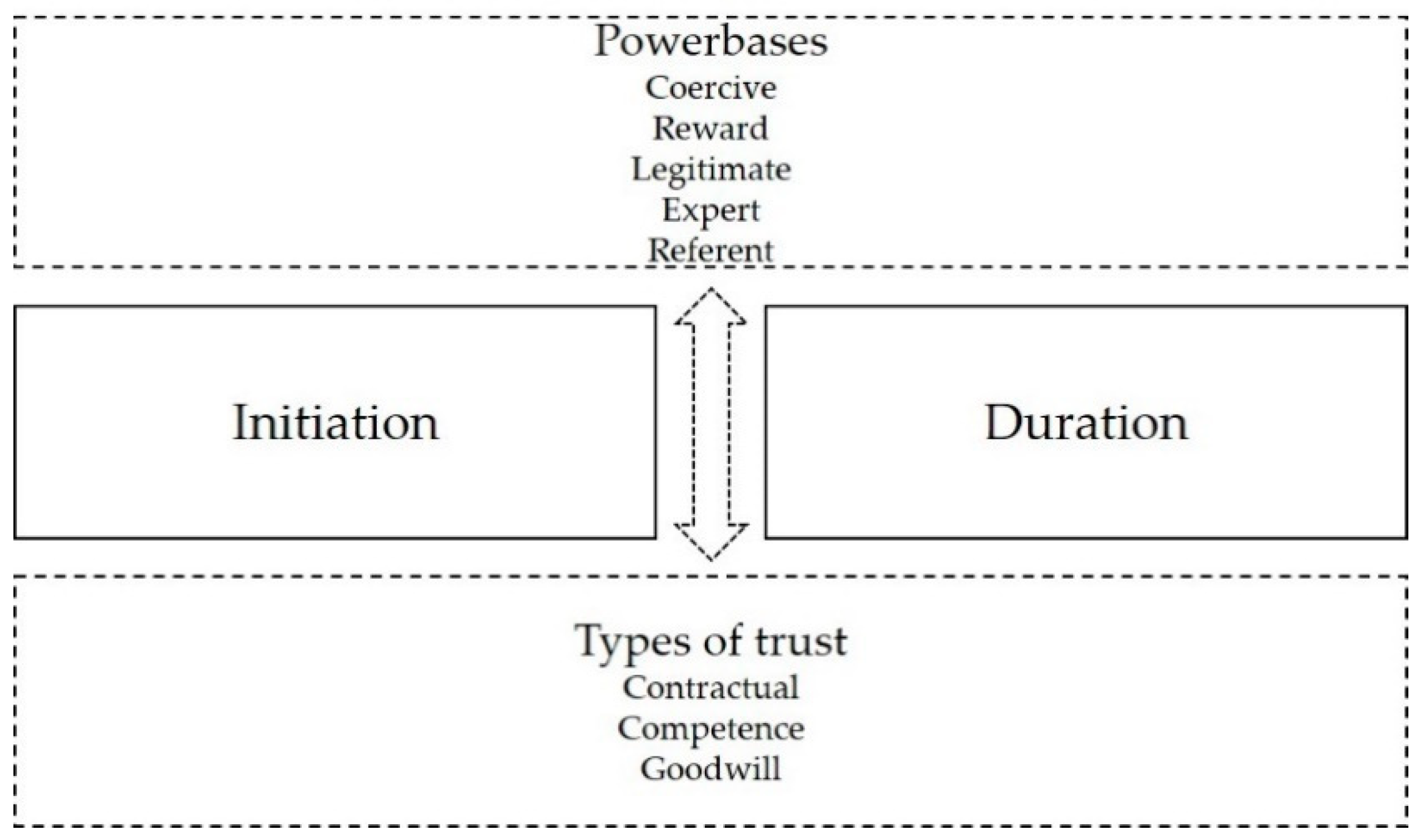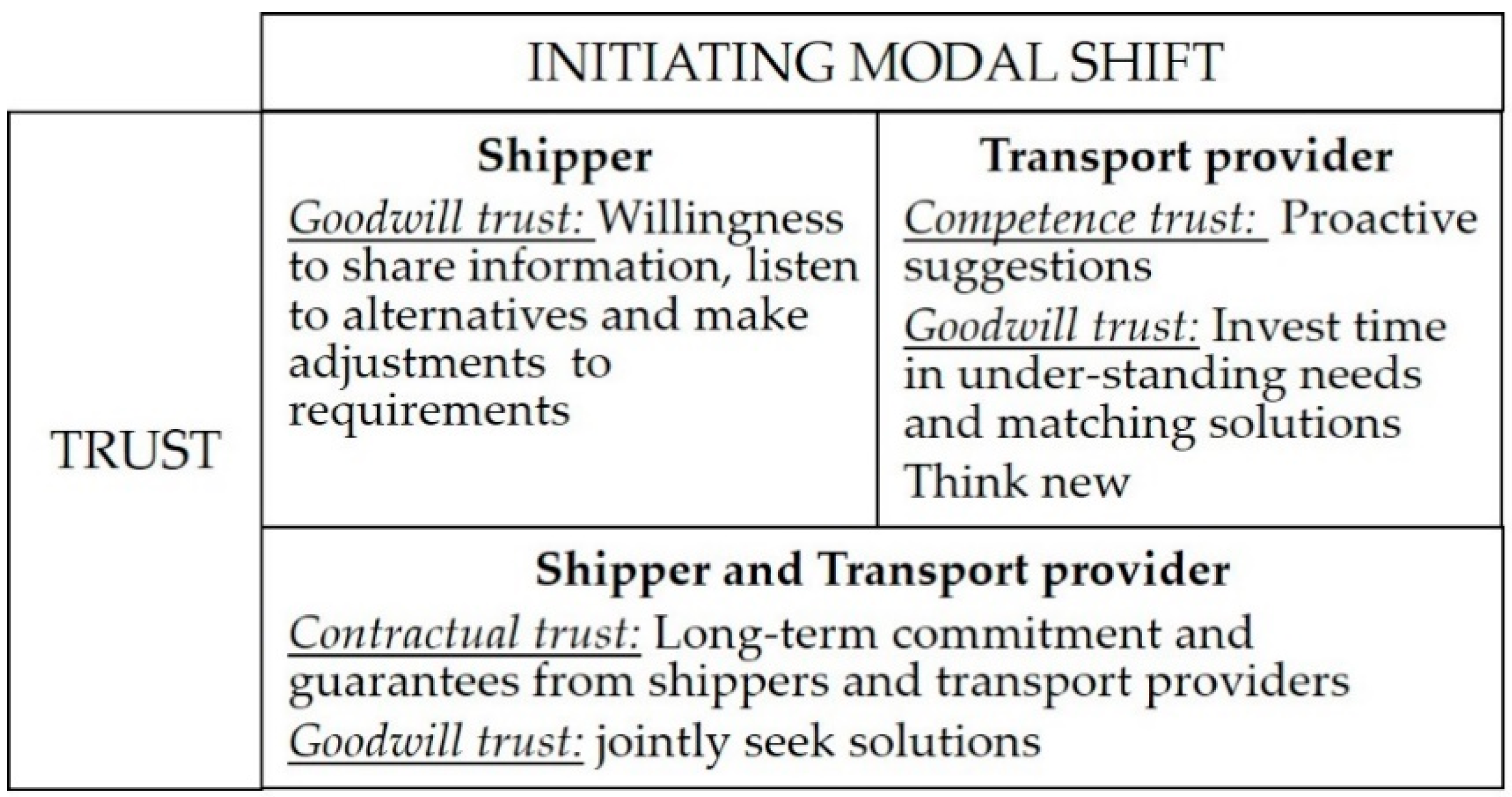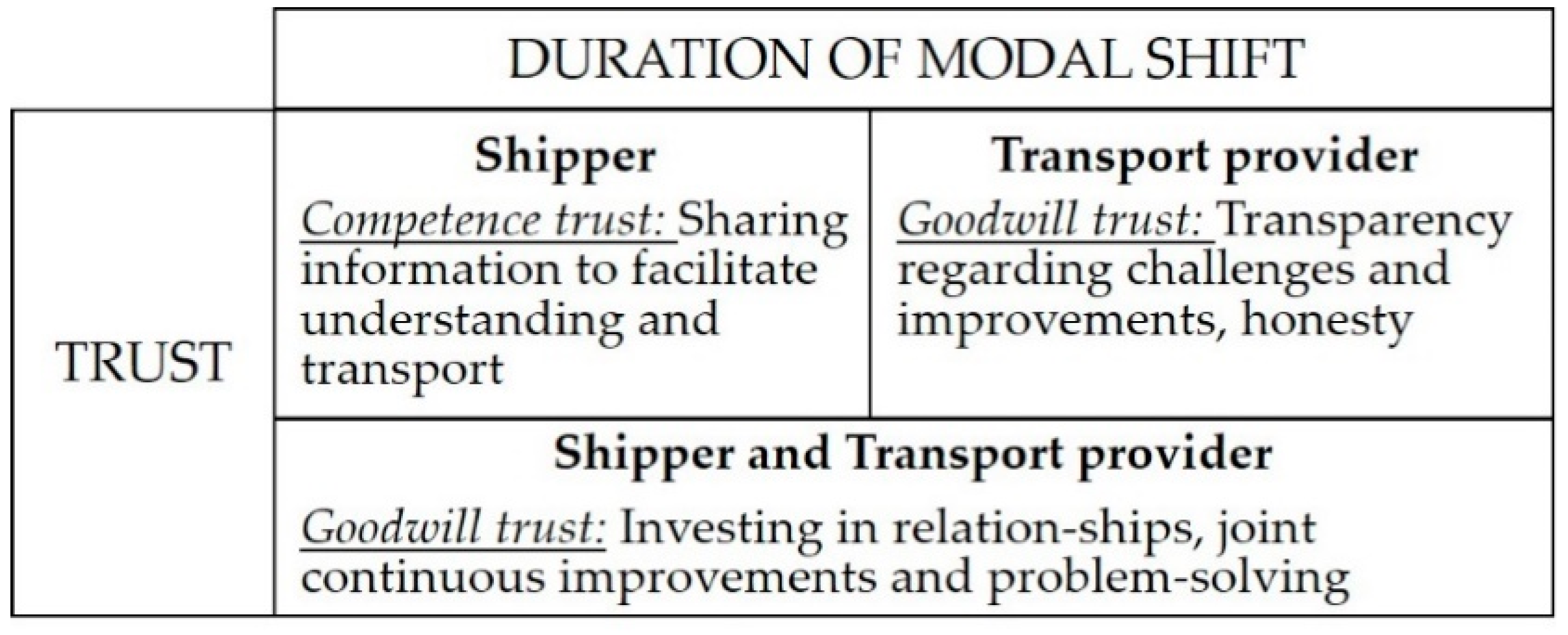The Influence of Power and Trust on the Initiation and Duration of Modal Shift Solutions
Abstract
1. Introduction
2. Conceptual Background
2.1. Phases of Logistical Change
2.2. Bases of Power
2.3. Types of Trust
2.4. Conceptual Model
3. Methods
4. Empirical Results
4.1. Power
4.2. Trust
5. Discussion
5.1. Initiation of a Modal Shift
5.2. Duration of Modal Shift
5.3. The Interplay between Power and Trust
6. Conclusions
Author Contributions
Funding
Institutional Review Board Statement
Informed Consent Statement
Data Availability Statement
Conflicts of Interest
References
- Woodburn, A.; Whiteing, A. Tranferring Freight to “Greener” Transport Modes. In Green Logistics: Improving the Environmental Sustainability of Logistics, 3rd ed.; McKinnon, A., Browne, M., Piecyk, M., Whiteing, A., Eds.; Kogan Page: London, UK, 2015; pp. 148–164. [Google Scholar]
- Pinchasik, D.R.; Hovi, I.B.; Mjøsund, C.S.; Grønland, S.E.; Fridell, E.; Jerksjö, M. Crossing Borders and Expanding Modal Shift Measures: Effects on Mode Choice and Emissions from Freight Transport in the Nordics. Sustainability 2020, 12, 894. [Google Scholar] [CrossRef]
- Chen, S.; Wu, J.; Zong, Y. The Impact of the Freight Transport Modal Shift Policy on China’s Carbon Emissions Reduction. Sustainability 2020, 12, 583. [Google Scholar] [CrossRef]
- McKinnon, A.C. Freight Transport Deceleration: Its Possible Contribution to the Decarbonisation of Logistics. Transp. Rev. 2016, 36, 418–436. [Google Scholar] [CrossRef]
- Giusti, R.; Manerba, D.; Bruno, G.; Tadei, R. Synchromodal logistics: An overview of critical success factors, enabling tech-nologies, and open research issues. Transp. Res. Part E Logist. Transp. Rev. 2019, 129, 92–110. [Google Scholar] [CrossRef]
- Commission, E. EU Transport in Figures; Imprimerie Centrale: Luxembourg, 2018. [Google Scholar]
- Rogerson, S.; Santén, V.; Svanberg, M.; Williamsson, J.; Woxenius, J. Modal shift to inland waterways: Dealing with barriers in two Swedish cases. Int. J. Logist. Res. Appl. 2019, 23, 195–210. [Google Scholar] [CrossRef]
- Raza, Z.; Svanberg, M.; Wiegmans, B. Modal shift from road haulage to short sea shipping: A systematic literature review and research directions. Transp. Rev. 2020, 40, 382–406. [Google Scholar] [CrossRef]
- Elbert, R.; Seikowsky, L. The influences of behavioral biases, barriers and facilitators on the willingness of forwarders’ decision makers to modal shift from unimodal road freight transport to intermodal road–rail freight transport. J. Bus. Econ. 2017, 87, 1083–1123. [Google Scholar] [CrossRef]
- Vierth, I.; Lindgren, S.; Lobig, A.; Matteis, T.; Liedtke, G.; Burgschweiger, S.; Niérat, P.; Blanquart, C.; Bogers, E.; Davydenko, I.; et al. FALCON Handbook: Understanding What Influences Modal Choice; CEDR Contractor Report 2017-07; CEDR: Brussels, Belgium, 2017. [Google Scholar]
- Rogerson, S. Influence of freight transport purchasing processes on logistical variables related to CO2 emissions: A case study in Sweden. Int. J. Logist. Res. Appl. 2017, 20, 604–623. [Google Scholar] [CrossRef]
- Lammgård, C.; Andersson, D. Environmental considerations and trade-offs in purchasing of transportation services. Res. Transp. Bus. Manag. 2014, 10, 45–52. [Google Scholar] [CrossRef]
- Bask, A.; Rajahonka, M. The role of environmental sustainability in the freight transport mode choice: A systematic literature review with focus on the EU. Int. J. Phys. Distrib. Logist. Manag. 2017, 47, 560–602. [Google Scholar] [CrossRef]
- Meers, D.; Macharis, C.; Vermeiren, T.; Van Lier, T. Modal choice preferences in short-distance hinterland container transport. Res. Transp. Bus. Manag. 2017, 23, 46–53. [Google Scholar] [CrossRef]
- Eng-Larsson, F.; Norrman, A. Modal shift for greener logistics—Exploring the role of the contract. Int. J. Phys. Distrib. Logist. Manag. 2014, 44, 721–743. [Google Scholar] [CrossRef]
- Holguín-Veras, J.; Xu, N.; De Jong, G.; Maurer, H. An Experimental Economics Investigation of Shipper-carrier Interactions in the Choice of Mode and Shipment Size in Freight Transport. Netw. Spat. Econ. 2011, 11, 509–532. [Google Scholar] [CrossRef]
- Styhre, L.; Rogerson, S.; Santén, V. Modal shift to short sea shipping from a transport purchasing perspective. In Proceedings of the NOFOMA Conference, Oslo, Norway, 13–14 June 2019. [Google Scholar]
- French, J.R.; Raven, B. The Bases of Social Power. In Studies in Social Power; Cartwright, D., Ed.; University of Michigan Press: Ann Arbor, MI, USA, 1959. [Google Scholar]
- Sako, M. Price, Quality and Trust: Inter-Firm Relations in Britain and Japan; Cambridge University Press: Cambridge, UK, 1992. [Google Scholar]
- Fulconis, F.; Nollet, J.; Paché, G. Purchasing of logistical services: A new view of LSPs’ proactive strategies. Eur. Bus. Rev. 2016, 28, 449–466. [Google Scholar] [CrossRef]
- Wolf, C.; Seuring, S. Environmental impacts as buying criteria for third party logistical services. Int. J. Phys. Distrib. Logist. Manag. 2010, 40, 84–102. [Google Scholar] [CrossRef]
- Makukha, K.; Gray, R. Logistics Partnerships Between Shippers and Logistics Service Providers: The Relevance of Strate-gy. Int. J. Logist. Res. Appl. 2004, 7, 361–377. [Google Scholar] [CrossRef]
- Jazairy, A.; Lenhardt, J.; Von Haartman, R. Improving logistics performance in cross-border 3PL relationships. Int. J. Logist. Res. Appl. 2017, 20, 491–513. [Google Scholar] [CrossRef]
- Monios, J.; Bergqvist, R. Using a “virtual joint venture” to facilitate the adoption of intermodal transport. Supply Chain Manag. Int. J. 2015, 20, 534–548. [Google Scholar] [CrossRef]
- Sallnäs, U. Coordination to Manage Dependencies between Logistics Service Providers and Shippers: An Environmental Perspective. Int. J. Phys. Distrib. Logist. Manag. 2016, 46, 316–340. [Google Scholar] [CrossRef]
- Rajesh, R.; Pugazhendhi, S.; Ganesh, K.; Yves, D.; Koh, S.C.L.; Muralidharan, C. Perceptions of service providers and customers of key success factors of third-party logistics relationships‑an empirical study. Int. J. Logist. Res. Appl. 2011, 14, 221–250. [Google Scholar] [CrossRef]
- Horak, S.; Long, C.P. Dissolving the Paradox: Toward a Yin–Yang Perspective on the Power and Trust Antagonism in Col-laborative Business Relationships. Supply Chain Manag. Int. J. 2018, 23, 573–590. [Google Scholar] [CrossRef]
- Ireland, R.D.; Webb, J.W. A multi-theoretic perspective on trust and power in strategic supply chains. J. Oper. Manag. 2007, 25, 482–497. [Google Scholar] [CrossRef]
- van Hoek, R.; Johnson, M.; Godsell, J.; Birtwistle, A. Changing chains: Three Case Studies of the Change Management Needed to Reconfigure European Supply Chains. Int. J. Logist. Manag. 2010, 21, 230–250. [Google Scholar] [CrossRef]
- Fawcett, S.E.; Fawcett, A.M.; Watson, B.J.; Magnan, G.M. Peeking Inside the Black Box: Toward an Understanding of Supply Chain Collaboration Dynamics. J. Supply Chain Manag. 2012, 48, 44–72. [Google Scholar] [CrossRef]
- Björklund, M.; Forslund, H. Exploring the sustainable logistics innovation process. Ind. Manag. Data Syst. 2018, 118, 204–217. [Google Scholar] [CrossRef]
- Ross, A.; Venkataramanan, M.A.; Ernstberger, K.W. Reconfiguring the Supply Network Using Current Performance Da-ta. Decis. Sci. 1998, 29, 707–728. [Google Scholar] [CrossRef]
- Hisano Barbosa, D.; Andreotti Musetti, M. The Use of Performance Measurement System in Logistics Change Process: Proposal of a Guide. Int. J. Product. Perform. Manag. 2011, 60, 339–359. [Google Scholar] [CrossRef]
- Dahl, R.A. The concept of power. Syst. Res. Behav. Sci. 2007, 2, 201–215. [Google Scholar] [CrossRef]
- Emerson, R.M. Power-Dependence Relations. Am. Sociol. Rev. 1962, 27, 31. [Google Scholar] [CrossRef]
- Cox, A.; Ireland, P.; Lonsdale, C.; Sanderson, J.; Watson, G. Supply Chains, Market and Power‑Mapping Buyer and Supplier Power Regimes; Routledge: London, UK, 2002. [Google Scholar]
- Stannack, P. Purchasing Power and Supply Chain Management Power‑Two Different Paradigms?—A Response to Ramsay’s ‘Purchasing power’ (1995). Eur. J. Purch. Supply Manag. 1996, 2, 47–56. [Google Scholar] [CrossRef]
- Gaski, J.F. The Theory of Power and Conflict in Channels of Distribution. J. Mark. 1984, 48, 9–29. [Google Scholar] [CrossRef]
- Cook, K.S. Exchange and Power in Networks on Interorganizational Relations. Sociol. Q. 1977, 18, 62–82. [Google Scholar] [CrossRef]
- Clegg, S.R. Frameworks of Power; SAGE Publications: New York, NY, USA, 1989. [Google Scholar]
- Hardy, C. Understanding Power: Bringing about Strategic Change. Br. J. Manag. 1996, 7, S3–S16. [Google Scholar] [CrossRef]
- Hunt, S.D.; Nevin, J.R. Power in a Channel of Distribution: Sources and Consequences. J. Mark. Res. 1974, 11, 186–193. [Google Scholar] [CrossRef]
- Maloni, M.; Benton, W.C. Power Influences in the Supply Chain. J. Bus. Logist. 2000, 21, 49–73. [Google Scholar]
- Flynn, B.B.; Zhao, X.; Huo, B.; Yeung, J.H.Y. We’ve Got the Power! How Customer Power Affects Supply Chain Relation-ships. Bus. Horiz. 2008, 51, 169–174. [Google Scholar] [CrossRef]
- Belaya, V.; Hanf, J.H. The Two Sides of Power in Business-to-Business Relationships: Implications for Supply Chain Man-agement. Mark. Rev. 2009, 9, 361–381. [Google Scholar] [CrossRef]
- Zhao, X.; Huo, B.; Flynn, B.; Yeung, J.H.Y. Effect of Customer Power on Supply Chain Integration and Performance. In Managing Global Supply Chains Relationships: Operations, Strategies and Practices; Flynn, B., Morita, M., Machuca, J., Eds.; Business Science Reference: New York, NY, USA, 2010. [Google Scholar]
- Johnson, J.L.; Sakano, T.; Cote, J.A.; Onzo, N. The Exercise of Interfirm Power and its Repercussions in U.S.-Japanese Channel Relationships. J. Mark. 1993, 57, 1. [Google Scholar] [CrossRef]
- Etgar, M. Selection of an Effective Channel Control Mix. J. Mark. 1978, 42, 53–58. [Google Scholar]
- Belaya, V.; Hanf, J.H. The Dark and the Bright side of Power: Implications for the Management of Business-to-Business Rela-tionships. Agric. Food Econ. 2016, 4, 1–17. [Google Scholar] [CrossRef]
- Kumar, N. The power of power in supplier–retailer relationships. Ind. Mark. Manag. 2005, 34, 863–866. [Google Scholar] [CrossRef]
- Vale, J.; Ribeiro, J.; Branco, M.C. A Relational Approach to the Creation and Deterioration of Intellectual Capital in Me-ta-Organizations: The Case of a Seaport. Int. J. Transp. Econ. 2018, 45, 123–147. [Google Scholar]
- Vale, J.; Ribeiro, J.A.; Branco, M.C. Intellectual Capital Management and Power Mobilisation in a Seaport. J. Knowl. Manag. 2017, 21. [Google Scholar] [CrossRef]
- Cuevas, J.M.; Julkunen, S.; Gabrielsson, M. Power symmetry and the development of trust in interdependent relationships: The mediating role of goal congruence. Ind. Mark. Manag. 2015, 48, 149–159. [Google Scholar] [CrossRef]
- Kumar, N. The Power of Trust in Manufacturer-Retailer Relationships. Harvard Bus. Rev. 1996, 74, 92–106. [Google Scholar]
- Kumar, N.; Scheer, L.K.; Steenkamp, J.-B.E.M. The Effects of Supplier Fairness on Vulnerable Resellers. J. Mark. Res. 1995, 32, 54–65. [Google Scholar] [CrossRef]
- Mayer, R.C.; Davis, J.H.; Schoorman, F.D. An Integrative Model of Organizational Trust. Acad. Manag. Rev. 1995, 20, 709–734. [Google Scholar] [CrossRef]
- Dyer, J.H.; Chu, W. The determinants of trust in supplier–automaker relationships in the US, Japan, and Korea. J. Int. Bus. Stud. 2010, 42, 10–27. [Google Scholar] [CrossRef]
- Sako, M.; Helper, S. Determinants of trust in supplier relations: Evidence from the automotive industry in Japan and the United States. J. Econ. Behav. Organ. 1998, 34, 387–417. [Google Scholar] [CrossRef]
- Arvidsson, A.; Melander, L. The Multiple Levels of Trust when Selecting Suppliers‑Insights from an Automobile Manufac-turer. Ind. Mark. Manag. 2020, 87, 138–149. [Google Scholar] [CrossRef]
- Axelrod, R. The Evolution of Cooperation; Basic Books: New York, NY, USA, 1984; p. 241. [Google Scholar]
- Kwon, I.-W.G.; Suh, T. Factors Affecting the Level of Trust and Commitment in Supply Chain Relationships. J. Supply Chain Manag. 2004, 40, 4–14. [Google Scholar] [CrossRef]
- Ran, B.; Qi, H. Contingencies of power sharing in collaborative governance. Am. Rev. Public Adm. 2018, 48, 836–851. [Google Scholar] [CrossRef]
- Yin, R.K. Case Study Research: Design and Methods; Sage Publications: Thousand Oaks, CA, USA, 2009. [Google Scholar]
- Bryman, A.; Bell, E. Business Research Methods, 3rd ed.; Oxford University Press: New York, NY, USA, 2011. [Google Scholar]
- Patton, M.Q. Qualitative Research & Evaluation Methods, 3rd ed.; Sage Publications: New York, NY, USA, 2002; p. 598. [Google Scholar]
- Bask, A.; Rajahonka, M.; Laari, S.; Solakivi, T.; Töyli, J.; Ojala, L. Environmental Sustainability in Shipper-LSP Relationships. J. Clean. Prod. 2018, 172, 2986–2998. [Google Scholar] [CrossRef]
- Kogg, B. Greening a Cotton-textile Supply Chain. Greener Manag. Int. 2003, 2003, 52–64. [Google Scholar] [CrossRef]
- Vannieuwenhuyse, B.; Gelders, L.; Pintelon, L. An online decision support system for transportation mode choice. Logist. Inf. Manag. 2003, 16, 125–133. [Google Scholar] [CrossRef]
- Flodén, J.; Bärthel, F.; Sorkina, E. Transport Buyers Choice of Transport Service‑A Literature Review of Empirical Results. Res. Transp. Bus. Manag. 2017, 23, 35–45. [Google Scholar] [CrossRef]
- Ülgen, V.S.; Björklund, M.; Simm, N.; Forslund, H. Inter-Organizational Supply Chain Interaction for Sustainability: A Systematic Literature Review. Sustainability 2019, 11, 5488. [Google Scholar] [CrossRef]
- Meqdadi, O.; Johnsen, T.E.; Johnsen, R.E. The role of power and trust in spreading sustainability initiatives across supply networks: A case study in the bio-chemical industry. Ind. Mark. Manag. 2017, 62, 61–76. [Google Scholar] [CrossRef]





| Company | Mode | Role of Interviewee | Type of Company | Date of Interview |
|---|---|---|---|---|
| Transport provider A | Rail | District manager | International logistics service provider | 1. May 2019, 2. September 2020 |
| Transport provider B | Rail | CEO | Provider of rail freight services in specific geographical regions in Sweden | April 2019 |
| Transport provider C | Rail | Manager environmental affairs | International logistics service provider, division of freight deliveries | May 2019 |
| Transport provider D | Sea | Director ocean freight | International logistics service provider, division of global forwarding | April 2019 |
| Transport provider E | Rail | Strategic account manager | Provider of rail freight services in Sweden and to/from Europe | May 2019 |
| Shipper A | Sea | Head of supply chain | Retailer acting within the Nordic market | 1. April 2019, 2. May 2019 |
| Shipper B | Rail | Logistics manager | Retailer with stores in northern Europe | March 2019 |
| Shipper C | Rail | Head of transport | Retailer with stores in northern Europe | August 2020 |
| Type | Examples of Relevance for Modal Shift | Phase | Interview |
|---|---|---|---|
| Expert Power | Transport provider knows more about possible transport solutions | Initiation, Duration | Shipper A Transport provider A, B, C, D |
| Shipper(s) lack knowledge regarding sea/rail | Initiation | Shipper A | |
| Being first to make suggestions | Initiation | Transport provider A, C | |
| Transport provider has an extensive set of offers | Initiation | Shipper A, B, C Transport provider E | |
| Reward Power | Improved environmental performance | Initiation, Duration | Shipper A, B Transport provider A, |
| Lower costs | Initiation, Duration | Shipper A | |
| Increased sales | Initiation | Shipper C Transport provider A | |
| Award contract | Duration | Shipper C | |
| Coercive Power | Setting requirements and controlling demands | Initiation | Shipper C Transport provider A |
| Shippers threaten to substitute provider | Duration | Shipper A, C | |
| Provider only offers one solution/alternative | Initiation, Duration | Transport provider A | |
| Referent Power | Contacted based on reputation | Initiation | Shipper C Transport provider A, B, D |
| Legitimate Power | Daring to think of new solutions | Initiation | Transport provider B |
| Selecting the market leader | Initiation | Transport provider E | |
| Dependence due to integration/joint history | Initiation, Duration | Shipper C | |
| Desire/company culture to reduce road transport | Initiation, Duration | Transport provider A |
| Type | Examples of Relevance for Modal Shift | Phase | Interview |
|---|---|---|---|
| Contractual Trust | Guaranteed long-term commitment | Initiation, Duration | Shipper B |
| Length of business agreements/relationships | Initiation, Duration | Shipper A Transport provider A, B, C, | |
| Additional services contracted | Initiation, Duration | Shipper A, C | |
| Fulfilling service agreements | Duration | Shipper C | |
| Competence Trust | Transport provider knowledgeable about shipping/rail options | Initiation | Shipper A Transport provider C, D |
| Proactive suggestions from transport provider | Initiation, Duration | Shipper A Transport provider B, C | |
| Goodwill Trust | Jointly seeking solutions | Initiation | Shipper A Transport provider A, D |
| Invested in understanding each other | Initiation, Duration | Shipper A, C Transport provider A, D | |
| Spirit for new solutions/Entrepreneurship | Initiation | Shipper A, C | |
| Prepared to make adjustments | Initiation | Shipper A, C Transport provider A | |
| Information sharing by system integration | Duration | Shipper C | |
| Honesty and transparency regarding challenges | Initiation, Duration | Shipper A, B Transport provider A |
Publisher’s Note: MDPI stays neutral with regard to jurisdictional claims in published maps and institutional affiliations. |
© 2021 by the authors. Licensee MDPI, Basel, Switzerland. This article is an open access article distributed under the terms and conditions of the Creative Commons Attribution (CC BY) license (http://creativecommons.org/licenses/by/4.0/).
Share and Cite
Rogerson, S.; Santén, V.; Sallnäs, U. The Influence of Power and Trust on the Initiation and Duration of Modal Shift Solutions. Sustainability 2021, 13, 3757. https://doi.org/10.3390/su13073757
Rogerson S, Santén V, Sallnäs U. The Influence of Power and Trust on the Initiation and Duration of Modal Shift Solutions. Sustainability. 2021; 13(7):3757. https://doi.org/10.3390/su13073757
Chicago/Turabian StyleRogerson, Sara, Vendela Santén, and Uni Sallnäs. 2021. "The Influence of Power and Trust on the Initiation and Duration of Modal Shift Solutions" Sustainability 13, no. 7: 3757. https://doi.org/10.3390/su13073757
APA StyleRogerson, S., Santén, V., & Sallnäs, U. (2021). The Influence of Power and Trust on the Initiation and Duration of Modal Shift Solutions. Sustainability, 13(7), 3757. https://doi.org/10.3390/su13073757






